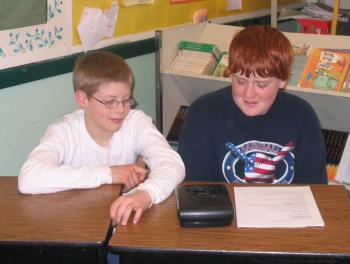Jimmy R.

Finding Friendship Oral History Project
The Finding Friendship Oral History Project is a joint effort of the Friendship Museum and the Friendship Village School, directed by Sally Merrick, museum volunteer, and Gaylea Hynd, teacher. In 2003-2004 sixth grade students conducted taped interviews of three generations of lobstermen and women, as well as others associated with the lobstering industry. Printed copies of the interviews and CDs of the printed transcripts are available at the Friendship Museum in Friendship, Maine.
Sally Merrick
Jimmy is a young and experienced lobsterman hailing from Friendship Village. He has been lobstering with his father or grandfather since he was five or six years old. Almost everyone in his family, except his younger brother, engages in lobstering.
Scope and Content Note
The interview with Jimmy at Friendship Village School focused on his lobstering experience. Jimmy goes lobstering with his father and occasionally his grandfather, dedicating five to six days a week during summer and weekends during the school year. He explains the process of acquiring a license by completing an application sent to Inland Fisheries in Augusta. Jimmy mentions fishing locations along the coast of Maine, including Otter Island, Long Island, Shark Rock, Mosquito Rock, and Egg Rock. His daily routine starts at 3:30 a.m. He works as the sternman on the boat, responsible for baiting the bags, attaching them to traps, and banding the lobsters. Traps are set by pushing them overboard from the washboard and paying out the rope. The length of the line varies from 5 to 25 fathoms depending on the fishing location. Jimmy describes his pot buoy as having a white top, green bottom, and a red tail. Jimmy primarily uses herring as bait but occasionally employs pogies, redfish, or flatfish. He sets around 50 traps and hauls in approximately 200 to 240 traps on a typical day. The catch volume can vary, and this year's harvest hasn't been particularly bountiful, yielding around 300 or fewer lobsters. The largest lobster catch Jimmy had was approximately the length of a trap. Hauling traps involves approaching the buoy, gaffing the rope, and using a hauler to bring the trap up. Traps come in different sizes, ranging from 2 to 4 feet, weighing between 50 and 60 pounds. When handling lobsters, Jimmy advises grabbing them by the knuckle to prevent bites and mentions that legal size ranges from 3 1/4 to 5 inches. Possessing undersized or v-notched lobsters can result in warnings, fines, or license revocation. The interview also touches upon other fish caught in traps, Jimmy's preference for codfish, and encountering crabs during lobstering. When preparing for hauling, Jimmy wears oil pants, a raincoat if it's raining, and suitable boots. He expresses his fondness for eating lobster and finds satisfaction in the work and financial rewards. The least enjoyable aspects were the early wake-up time and dragging bait down to the wharf. The interview concludes with Jimmy confirming his use of toggles and providing a brief description of the parts of a lobster trap, consisting of a wire box with heads and a bait line.
Please Note: The oral histories in this collection are protected by copyright and have been created for educational, research and personal use as described by the Fair Use Doctrine in the U.S. Copyright law. Please reach out Voices@noaa.gov to let us know how these interviews are being used in your research, project, exhibit, etc. The Voices staff can help provide other useful resources related to your inquiry.
The NOAA mission is to understand and predict changes in climate, weather, oceans, and coasts, to share that knowledge and information with others, and to conserve and manage coastal and marine ecosystems and resources. The Voices Oral History Archives offers public access to a wide range of accounts, including historical materials that are products of their particular times, and may contain offensive language or negative stereotypes.
Voices Oral History Archives does not verify the accuracy of materials submitted to us. The opinions expressed in the interviews are those of the interviewee only. The interviews here have been made available to the public only after the interviewer has confirmed that they have obtained consent.
